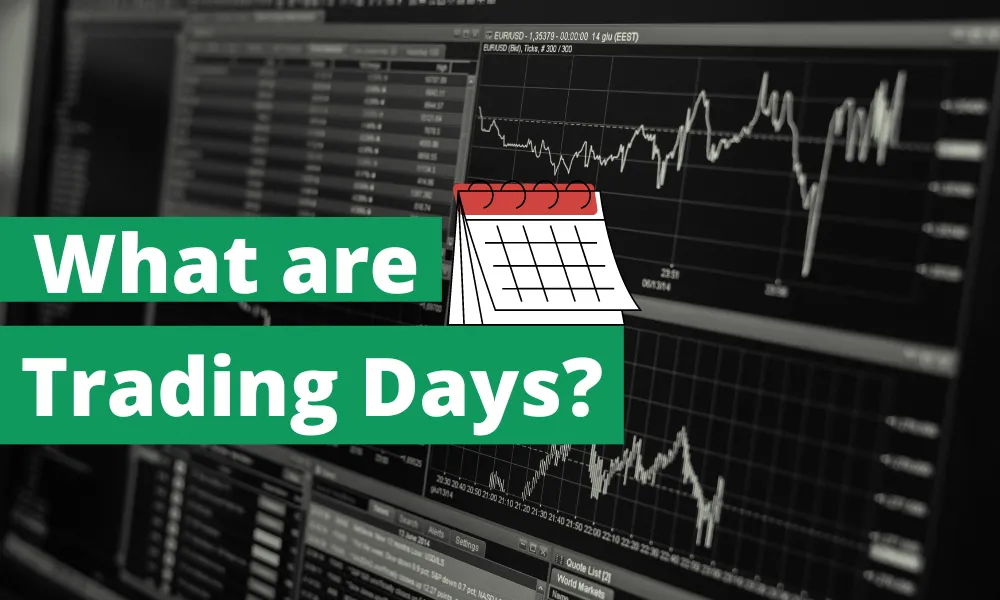In the world of business and investing, time is crucial.
Traders and investors are constantly monitoring the markets, analyzing data and making critical decisions.
But have you ever wondered how many trading days there are in a year?
Understanding the concept of trading days is essential for anyone involved in the stock market.
The number of trading days in a year has a significant impact on investment strategies, portfolio planning and overall market activity.
What are Trading Days?

Trading days are the days when financial markets are open and actively trading securities.
Unlike calendar days, trading days exclude weekends, public holidays and other non-business days.
These days are important because they determine the availability of trading opportunities and influence investment decision-making.
Factors Influencing the Number of Trading Days
The number of trading days in a year can vary depending on several factors. Here are some of the key factors that can influence the number of trading days:
1) Calendar Structure – The structure of the calendar used by a particular country or exchange can affect the number of trading days. Different countries have different public holidays and observances, which may lead to partial or full market closures.
For example, markets are typically closed on national holidays such as Christmas, New Year’s Day and Independence Day.
2) Weekends – Weekends, usually Saturdays and Sundays, are non-trading days in most stock markets worldwide. Therefore, the number of trading days is reduced by these days each week.
3) Exchange Holidays – In addition to weekends, stock exchanges often declare specific holidays or non-trading days. These can include public holidays specific to the country or region, as well as days for administrative purposes or scheduled maintenance. Such holidays can vary between different exchanges and can impact the overall number of trading days.
4) Half Days – Some exchanges may have half trading days, also known as shortened trading sessions, where trading occurs for a reduced number of hours. These half days are often observed on days preceding major holidays or other significant events.
5) Local Customs and Practices – Local customs and practices can also influence the number of trading days. For example, some markets may have a tradition of observing additional holidays or closing early on specific days that are culturally significant.
Calculation Method of Trading Days in an year
| Trading Days = Total Days in a Year – (Weekends + Holidays) |
Follow these steps to calculate trading days in an year:
Step 1: Start with the total number of days in the calendar year. This is usually 365 days in a non-leap year or 366 days in a leap year.
Step 2: Subtract the number of weekends (Saturdays and Sundays) from the total number of days.
Step 3: Subtract the number of public holidays that fall on regular trading days from the total.
Step 4: Some exchanges have additional holidays specific to their region or exchange. Subtract the number of these exchange-specific holidays from the total.
Step 5: If there are any half trading days observed by the exchange, adjust the count accordingly. A half trading day is typically considered as half a trading day, rather than a full trading day.
Also See: How Much Can You Make As a Day Trader?
Trading Days in Major Financial Markets
Here is table showcasing the number of trading days in a year for some major financial markets around the world
How many Trading Days are in 2023 (January-December)?
Here is the trading days calendar for 2023 from January to December.
| Month (2023) | Trading Days | Trading Hours |
|---|---|---|
| January | 20 | 130.0 |
| February | 19 | 123.0 |
| March | 23 | 149.5 |
| April | 19 | 123.5 |
| May | 22 | 143.0 |
| June | 21 | 136.5 |
| July | 20 | 127.0 |
| August | 23 | 149.5 |
| September | 20 | 130.0 |
| October | 22 | 143.0 |
| November | 21 | 133.5 |
| December | 20 | 130.0 |
How many trading days in a Week?
There are typically five trading days in a week.
This includes Monday through Friday. Weekends, which are Saturday and Sunday are non-trading days in most stock markets worldwide.
How many trading days in a Quarter?
The number of trading days in a quarter can vary depending on weekends, holidays and other factors.
On average, a quarter typically consists of around 63 trading days, but the actual count may differ based on the specific calendar, country, and exchange being considered.
How many trading weeks in a year?
There are typically around 52 trading weeks in a year.
This number can vary slightly depending on the specific calendar year and any additional non-trading days such as holidays or exchange closures.
How many trading days in 2024 (January-December)?
| Month (2024) | Trading Days | Trading Hours |
|---|---|---|
| January | 21 | 136.5 |
| February | 20 | 130.0 |
| March | 20 | 130.0 |
| April | 22 | 143.0 |
| May | 22 | 143.0 |
| June | 19 | 123.5 |
| July | 22 | 140.0 |
| August | 22 | 143.5 |
| September | 20 | 130.0 |
| October | 23 | 149.5 |
| November | 20 | 127.0 |
| December | 21 | 136.5 |
How many trading days in 2025 (January-December)?
| Month (2025) | Trading Days | Trading Hours |
|---|---|---|
| January | 21 | 136.5 |
| February | 19 | 123.5 |
| March | 21 | 136.5 |
| April | 21 | 136.5 |
| May | 21 | 136.5 |
| June | 20 | 130.0 |
| July | 22 | 140.0 |
| August | 21 | 136.5 |
| September | 21 | 136.5 |
| October | 23 | 149.5 |
| November | 19 | 120.5 |
| December | 22 | 140.0 |
How many hours do day traders spend?
On average, day traders typically spend 6 to 8 hours actively engaged in trading activities, closely monitoring the markets, conducting research and executing trades.
How many days a week stock market is open in USA?
The stock market in the United States is typically open for trading five days a week, from Monday to Friday.
It is closed on weekends (Saturday and Sunday) and observes specific holidays when trading is suspended.
What are the biggest stock market days in history?
The biggest stock market days in history are:
- Black Monday (October 19, 1987) – On this day, global stock markets experienced a significant crash, with the Dow Jones Industrial Average (DJIA) plunging by 22.6%.
- Global Financial Crisis (September 29, 2008) – Following the bankruptcy of Lehman Brothers, the DJIA dropped by 777.68 points, marking its largest single-day point decline at the time.
- COVID-19 Crash (March 16, 2020) – As the COVID-19 pandemic spread globally, major stock indices faced severe declines. The DJIA fell by 2,997 points or 12.93%, marking one of the worst days since the 1987 crash.
- Great Depression (October 28, 1929) – During the Great Depression, known as Black Monday, the DJIA experienced a massive drop of 38.33%, one of the largest percentage declines in history.
- Dotcom Bubble Burst (April 14, 2000) – Following the bursting of the dotcom bubble, the Nasdaq Composite Index fell by 355.49 points or 9.67%.
- Financial Crisis of 2008 (October 10, 2008) – During the height of the financial crisis, the DJIA faced a significant decline of 678.91 points or 7.33%.
- Flash Crash (May 6, 2010) – In a matter of minutes, the DJIA experienced a sharp decline of around 1,000 points (approximately 9%), only to recover most of the losses later that day.
- Brexit Referendum (June 24, 2016) – Following the unexpected outcome of the Brexit referendum, global stock markets reacted with substantial declines. The DJIA fell by 610.32 points or 3.39%.
- COVID-19 Recovery Rally (November 9, 2020) – On this day, several stock indices, including the DJIA and S&P 500, experienced significant gains as positive news about COVID-19 vaccine progress boosted investor sentiment.
- Dotcom Bubble Peak (March 10, 2000) – At the height of the dotcom bubble, the Nasdaq Composite Index reached its peak and closed at 5,048.62 points, a level that would not be surpassed for more than 15 years.
FAQs
How many trading days are there in a typical year?
A typical year has around 252 trading days, excluding weekends and holidays when the stock market is closed.
Are trading days consistent across all countries?
No, trading days can vary between countries based on their respective public holidays and market observances.
Do all stock exchanges have the same number of trading days?
No, different stock exchanges can have varying numbers of trading days based on local holidays and exchange-specific schedules.
Are half days counted as full trading days?
No, half days have reduced trading hours and are typically not considered as full trading days.
Can trading days change from year to year?
Yes, trading days can vary from year to year due to shifts in holidays, weekends, and exchange-specific closures.
Do market closures affect the count of trading days?
Yes, market closures on holidays or other non-trading days impact the total number of trading days in a year.
Are international stock markets synchronized in terms of trading days?
No, international stock markets have their own trading calendars, which can differ based on local holidays and observances.
Final words
Understanding the concept of trading days is essential for investors and traders navigating the dynamic world of financial markets.
By grasping the factors influencing the number of trading days, exploring different calculation methods and staying informed about trading calendars, investors can make well-informed decisions.
Remember to consider the impact of trading days on investment strategies and be aware of exceptions and special cases that may affect the overall count.
Armed with this knowledge, investors can navigate the markets with confidence and optimize their investment outcomes.

